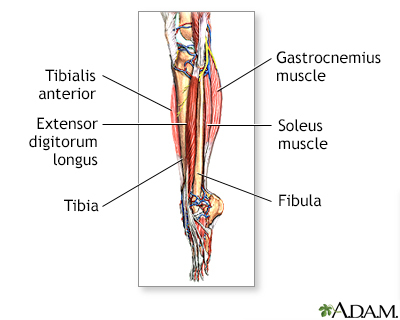Hand or foot spasms
Definition
Spasms are contractions of the muscles of the hands, thumbs, feet, or toes. Spasms are usually brief, but they can be severe and painful.
Alternative Names
Foot spasms; Carpopedal spasm; Spasms of the hands or feet; Hand spasms
Considerations
Symptoms depend on the cause. They may include:
- Cramping
- Fatigue
- Muscle weakness
- Numbness, tingling, or a "pins and needles" feeling
- Twitching
- Uncontrolled, purposeless, rapid motions
Nighttime leg cramps are common in older people.
Causes
Cramps or spasms in the muscles often have no clear cause.
Possible causes of hand or foot spasms include:
- Abnormal levels of electrolytes or minerals in the body
- Brain disorders, such as Parkinson disease, multiple sclerosis, dystonia, and Huntington disease
- Chronic kidney disease and dialysis
- Damage to a single nerve or nerve group (mononeuropathy) or multiple nerves (polyneuropathy) that are connected to muscles
- Dehydration (not having enough fluids in your body)
- Hyperventilation, which is rapid or deep breathing that can occur with anxiety or panic
- Muscle cramps, usually caused by overuse during sports or work activity
- Pregnancy, more often during the third trimester
- Thyroid disorders
- Too little vitamin D
- Use of certain medicines
Home Care
If vitamin D deficiency is the cause, vitamin D supplements may be suggested by the health care provider. Calcium supplements may also help.
Being active helps keep muscles loose. Aerobic exercise, especially swimming, and strength building exercises are helpful. But care must be taken not to overdo activity, which may worsen the spasms.
Drinking plenty of fluids during exercise is also important.
When to Contact a Medical Professional
If you notice recurrent spasms of your hands or feet, contact your provider.
What to Expect at Your Office Visit
The provider will perform a physical exam and ask about your medical history and symptoms.
Blood and urine tests may be done. Tests may include:
- Potassium, calcium and magnesium levels.
- Hormone levels.
- Kidney function tests.
- Vitamin D levels (25-OH vitamin D).
- Nerve conduction and electromyography tests may be ordered to determine if nerve or muscle disease is present.
Treatment depends on the cause of the spasms. For example, if they are due to dehydration, your provider will likely suggest you drink more fluids. Some studies suggest that certain medicines and vitamins may help.
Gallery


References
Chonchol M, Smogorzewski MJ, Stubbs JR, Yu ASL. Disorders of calcium, magnesium, and phosphate balance. In: Yu ASL, Chertow GM, Luyckx VA, Marsden PA, Skorecki K, Taal MW, eds. Brenner and Rector's The Kidney. 11th ed. Philadelphia, PA: Elsevier; 2020:chap 18.
Francisco GE, Li S. Spasticity. In: Cifu DX, ed. Braddom's Physical Medicine & Rehabilitation. 6th ed. Philadelphia, PA: Elsevier; 2021:chap 23.
Jankovic J, Lang AE. Diagnosis and assessment of Parkinson disease and other movement disorders. In: Jankovic J, Mazziotta JC, Pomeroy SL, Newman NJ, eds. Bradley and Daroff’s Neurology in Clinical Practice. 8th ed. Philadelphia, PA: Elsevier; 2022:chap 24.